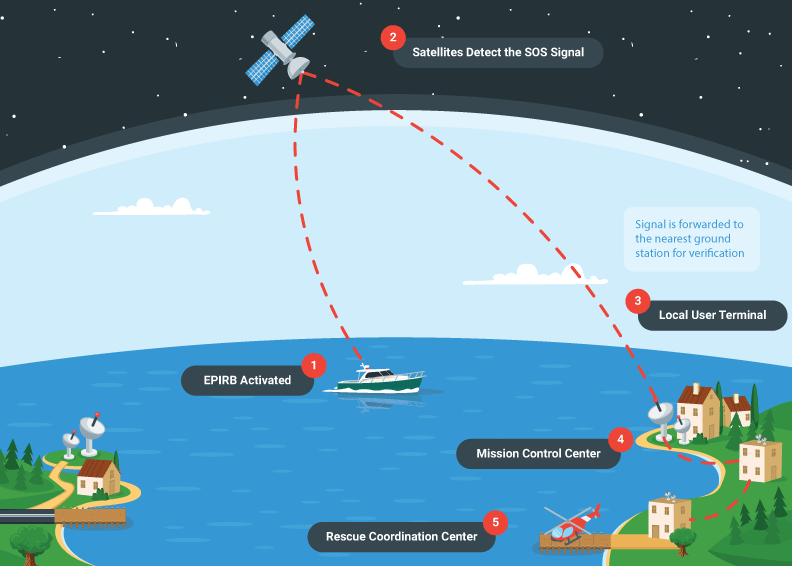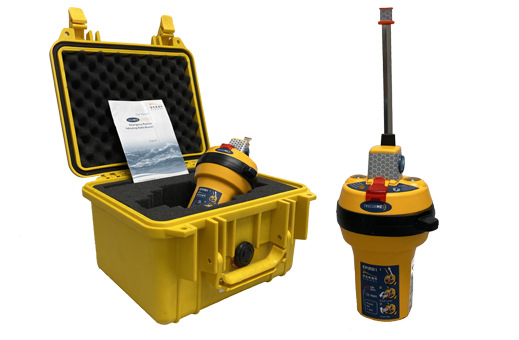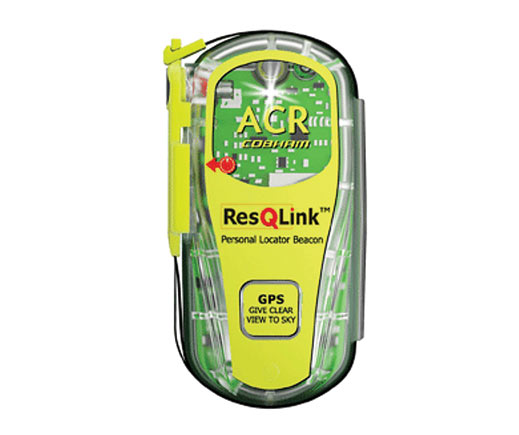How EPIRBs Work
EPIRBs provide worldwide coverage, position location accuracy, a reliable transmitted signal, an encoded message that identifies the distressed vessel, and a faster response time.
See RentalsEPIRB Information
All BoatU.S. Foundation EPIRBs are the 406 Mhz model and uses the COSPAS/SARSAT system of polar orbiting satellites. The advantages of a 406 EPIRB are worldwide coverage, position location accuracy, a reliable transmitted signal, an encoded message that identifies the distressed vessel, and a faster response time. For long offshore trips, a 406 EPIRB is the way to go. A GPS enabled 406 EPIRB's accuracy is roughly within 100 yards of the initial alert which is a vast improvement from the old 121.5 MHz EPIRBs.
Once registered and in the event of an activation, the unique encoded digital message is received by the satellites are then transmitted back to ground-based search and rescue authorities. This signal provides them with information to assist in the search: who you are, your boat type and size, where you are, and other important data, including emergency contact information. The encoded signal also performs the important function of circumventing false alarms, which was a frequent problem with the older style 121.5 EPIRB.
How EPIRBs Work: At a Glance
- Boater in distress activates 406 EPIRB.
- EPIRB’s repeating SOS signal is detected by earth-orbiting satellites.
- Signal is forwarded to ground station for verification.
- Ground station notifies central command (MCC) to initiate search and rescue.
- MCC notifies the Coast Guard or the Air Force Rescue Coordination Center (RCC) nearest to the boater’s location.
- The RCC calls BoatU.S. for vessel description prior to leaving base. RCC dispatches applicable search and rescue resources.

121.5 EPIRB Phase Out – U.S. Coast Guard Message
Beginning January 1, 2007, both 121.5 and 243 MHz Emergency Position Indicating Radio Beacons (EPIRBs) are prohibited from use in both commercial and recreational watercraft. Boaters wishing to have an emergency rescue beacon aboard their vessel must have a digital 406 MHz model.
The January 1, 2007, date to stop using 121.5 MHz EPIRBs is in preparation for February 1, 2009, when satellite processing of distress signals from all 121.5/243 MHz beacons will terminate. Following this termination date, only the 406 MHz beacons will be detected by the International Cospas-Sarsat Satellite System which provides distress alert and location data for search and rescue operations around the world.
The regulation applies to all Class A, B, and S 121.5/243 MHz EPIRBs. It does not affect 121.5/243 MHz man overboard devices which are designed to work directly with a base alerting unit only and not with the satellite system.
This change, in large part, was brought about by the unreliability of the 121.5/243 MHz beacons in an emergency situation. Data reveals that with a 121.5 MHz beacon, only one alert out of every 50 is a genuine distress situation. This has a significant effect on expending the limited resources of search and rescue personnel and platforms. With 406 MHz beacons, false alerts have been reduced significantly, and, when properly registered, can usually be resolved with a telephone call to the beacon owner. Consequently, real alerts can receive the attention they deserve.
EPIRB

A GPS enabled EPIRB or GPIRB is a 406 Mhz beacon that provides provides instant positioning information when the unit is activated in conjunction with a GPS. The GPS is either an internal component of the EPIRB or connected to the EPIRB via an interface. These represent the current state-of-the-art in 406Mhz EPIRBs. The location of a transmitting 406 beacon with GPS can be determined within approximately 100m (about 330 feet) of the first satellite pass!
PLB

Personal Locator Beacons, or PLBs are compact emergency equipment that also relies on the 406Mhz satellite signal. Weighing about a pound, these units can also have GPS accuracy. Battery life on these units is only required to transmit for 24 hours and they are not water activated. The compact design of these units makes them ideal for attaching to a person for outdoor activities. However, they are more complicated to use and do not offer the safety features of our 406 EPIRBs. We currently offer PLBs for rent.
